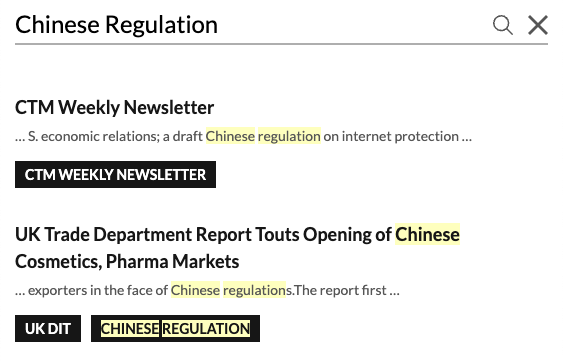Last month, China’s State Council approved the 14th-Five-Year-Plan on High Quality Development of Foreign Trade (link in Chinese), which is the development plan for trade over the period of 2021-2025. The document highlighted expanding trade through trade agreements and other domestic measures, and promoting the development of digital trade and green trade. China will also work on strengthening its supply chain and preparing to use tools to address “unfair competition.” It is worth noting that the document offers general guidance on future policies rather than binding commitments.
The trade development plan first reviewed China’s trade over the past several years. It states that:
In 2020, the total value of China’s trade in goods and services has jumped to the first place in the world, and China trades with more than 230 countries and regions. The total trade in goods increased from USD 3.95 trillion in 2015 to USD 4.65 trillion in 2020, an average annual growth rate of 3.3%, and the international market share of China’s trade increased from 13.8% to 14.7%. China has maintained its status as the largest country for trade in goods since 2017. The total amount of trade in services increased from USD 654.2 billion to USD 661.7 billion, ranking second in the world. The average annual growth rate of service exports reached 5.1%.
Ren Hongbin, vice-minister of the Ministry of Commerce, provided more updated information on trade during a press conference (link in Chinese) on November 24. He said that “between January and October (of 2021), the total import and export volume was USD 4.89 trillion, a year-on-year increase of 31.9%.
In addition, Ren said that “the international market is more diversified. Developing countries and emerging economies have become China’s main trading partners, accounting for 49.5% of China’s total exports. The main force of private enterprises has become more prominent, accounting for 57.6% of China’s total exports.”
The report noted some challenges China faces in international trade, including the wide impact of the COVID pandemic, rising protectionism and unilateralism, reshaping of the industrial supply chain, and trade security for food, energy resources, key technologies and components, among other things.
Ren also commented on the challenges facing Chinese trading companies, including high risks, rising costs, supply chain jams, reduced sales, shortage of chips, and shortage of labor. Therefore, he said, MOFCOM will “earnestly implement the ‘14th Five-Year’ foreign trade high-quality development plan.”
Overall, the trade development plan highlighted innovation as the main driving force for trade, and a transition to green and low-carbon trade as well as digital trade. At the same time, it stated that China would “thoroughly implement the holistic approach to national security” and “adhere to the unity of high-quality development of foreign trade and high-level security.”
The document set out ten major tasks for the next five years, including optimizing the structure of goods trade, developing service trade, digital trade, and green trade, and protecting the foreign trade supply chain.
With regard to goods trade, it stated that China would “actively expand trade with emerging markets such as Asia, Latin America and Africa” and “guide companies to explore a number of key markets and expand import sources, considering factors such as market scale, trade potential, consumption structure, industry complementarity, country-specific risks.” It also said it would “reduce import tariffs and systemic costs” and “promote imports from developing countries, especially the least developed countries,” “encourage the import of high-quality consumer goods, expand the import of advanced technology, important equipment, and key parts and components, and increase the import of energy and resource products and agricultural products that are in short supply domestically,” and “promote the import and export of green and low-carbon products such as environmental protection and new energy, and actively participate in international cooperation.”
With regard to trade in services and digital trade, it noted that China would “speed up the establishment of basic systems and standards for data rights, transaction, cross-border transfers, and security protection, and carry out security management pilot projects of cross-border data transfer, under the framework of the national security management system for data cross-border transfer.”
To better manage trade risks and frictions, the document stated that China would “use a variety of methods to deal with unfair competition and other behaviors.” It also noted that it would conduct security evaluation on industrial supply chain, actively engage in negotiations on trade remedy rules, and improve on the export control regime, including “properly responding to discriminatory behaviors such as abuse of export controls by foreign countries.”
The document also illustrates some measures to facilitate trade, including lowering the administrative cost on foreign trade, optimizing fiscal and tax tools, enhancing the level of financial service, and recruiting more talent.
During the press conference, Ren said that “we adhere to promoting the high-quality development of foreign trade centered on the supply-side structural reform. This is an inevitable requirement for building a new higher-level open economic system and enhancing our nation’s comprehensive national strength and international competitiveness.”
Ren also mentioned China’s effort to join more trade agreements:
We will actively promote the accession to the Comprehensive and Progressive Trans-Pacific Partnership Agreement, namely CPTPP, and the Digital Economy Partnership Agreement, namely DEPA, and promote the free trade negotiation process between China, Japan and South Korea, as well as negotiations with the Gulf Cooperation Council, Israel, and Norway. We are willing to sign free trade agreements with more trading partners.

